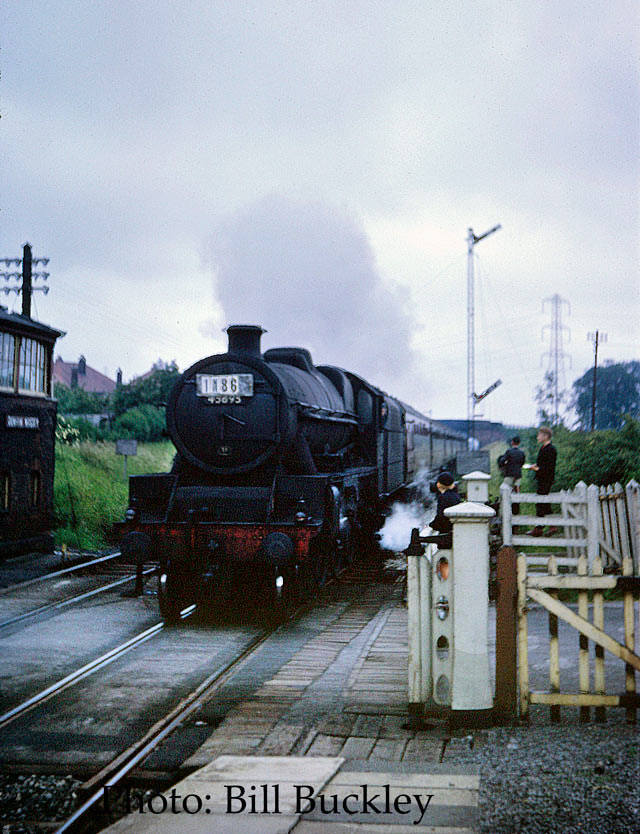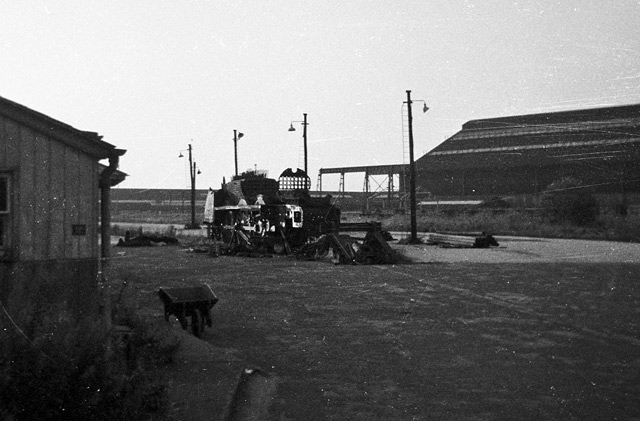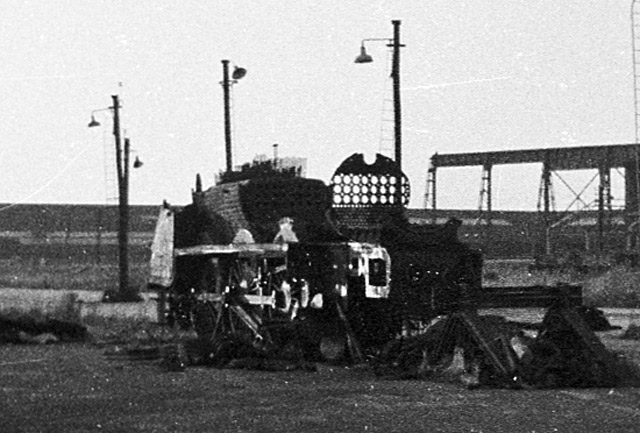
Jubilee Class 4-6-0 45695 Minotaur
Built: Crewe Works
Entered Service: 26th March 1936
Allocations:
Blackpool Central - 1/1/48 to 4/52
Bank Hall - 4/52 to 9/52
Farnley Jct - 9/52 to 1/64
(Source: BR Steam Locomotives Complete Allocations History 1948-1968 by Hugh Longworth)
Withdrawn: 18th January 1964
Scrapped: The locomotive was cut up on site at Broadheath goods yard. This would appear to have been a rather protracted operation. A correspondent ( Ted Buckley) recalls visiting the location on Sunday 27th September, i.e over eight months after the accident, and the frames, cab, and front tubeplate and smokebox were still in evidence - a slow and undignified end.
Locomotives used in the salvage operation were as follows:
42970 - Nuneaton (5E)
48310 - Longsight (9A)
70051 - Crewe North (5A)
48555 - Stoke (5D)
Minotaur's Final Journey - By Ken Millward
On the night of 17th/18th January 1964 a collision occurred at Broadheath near Altrincham between 1N07, the 2237 Up Mail train from Liverpool Lime Street to York, and a freight train.

43. Failures of a combination of staff in different departments
18th January. - The signalman at Broadheath (L.M. Region), on a line used almost exclusively by freight trains, intended to shunt a freight train from the Up to the Down line to allow the one Up Class 1 mail train that runs on it, to pass, but omitted to reverse the facing end of a crossover, with the result that the train was set back on the Up line; he then gave " Train Out of Section " and pulled off his signals for the mail train. The guard failed to check the lie of the points, as he should have done under the Rules when no shunt signal is provided, and the fireman also assumed the train had crossed over to the Down line and signed the Train Register in accordance with the Rules, for the Down line. By the time the driver and the guard realised what had happened, it was too late to avert a collision, which resulted in the engine of the mail train being turned over on its side, the first five coaches being derailed and the brakevan and last six wagons of the freight train being extensively damaged.
The late Peter Michie visited the scene and recorded the images below of the clear up.

(Above) This is the view from the overbridge, the point of the collision, looking towards Broadheath Station and signalbox. The large buildings on the right hand side of the photograph are the premises of the Churchill Machine Tool Company. In the distance, just beyond the ex-LNW semaphore, is the down siding where the engine of the Up Mail, Jubilee class 4-6-0 45695 Minotaur has been placed after recovery. The decision was later made to cut up the locomotive on site.

(Above) The tender from Minotaur is in the left side of the picture, standing in the Up lay-by siding. Behind this is one of the vans from the breakdown train. In the foreground is the shattered brakevan of the freight train complete with art work on its side panelling.

(Above and Below) These images of 45695 illustrate why this particular locomotive never went back into revenue earning service.

It is difficult to understand how this accident could possibly have happened. Granted the signalman on duty was a relief and the manouvre was perhaps not undertaken on a regular basis, but surely the crew of the freight train was familiar enough with this location to realise they were standing on the Up, and not the Down running line. The danger of not providing shunt signals at the crossover is also highlighted. By the date of the accident, the route was almost exclusively freight only which would possibly explain the lack of track circuits enabling the signalman to clear all his Up Main signals for the Mail.
The fate of the crews involved proved very difficult to verify, due mainly I suppose to the fact that no members of the public were involved and so no official accident report was published. However I have been contacted by Ted Buckley, who lived in the area at the time and has given presentations which include references to this incident. In his correspondence he has included the following:
"During my research for the presentation, I also visited the Central Library in Manchester and accessed the Manchester Evening News Archive, still on the old microfiche system. The MEN for Saturday 18th Jan reported on the crash on its front page, complete with a dramatic photo of the loco, similar to my Dad's, the late Bill Buckley. This report also gave some details on the crews involved. They treated the guard of the goods train as a hero, for waving his red lamp in an attempt to stop the mails. He was Robert Williams of Birkenhead, and he was unhurt. The mails guard was Walter Durr of Reddish, who was taken to hospital suffering from shock, the driver (of 45695) was Alexander Campbell, aged 61, of Huddersfield, who suffered burns to hands and face, but was described as 'satisfactory' in hospital, and his fireman (no name) was bruised. It seems to me they were all extremely lucky to escape with their lives; the goods guard could easily have been hit by the wreckage. I assume no sorting was taking place in this train, as there was no mention of anyone else. Looking at the shattered carriages, they would surely have been killed. The article also states that the police kept a close guard on the wreckage until all the mail was removed and that BR 'hoped to have trains passing again tonight' (ie Saturday night). In the event, it would have been Sunday evening / Monday morning. Contrast that with today - it would have been at least a week!"
I would like to record my gratitude to Ted, not only for the above passage but also for providing invaluable information which has enabled me to correct various errors which had crept into my first draft.
My thanks also to the late Edwin Bolas for allowing me to use his photographs of 45695.
Some Colour Views of the Crash Scene taken by Bill Buckley

(Above) The Gorton crane lifts the guards van of the goods train from its resting place. The force of the impact had thrown it from the up line, on which the crane is standing, across the siding, and onto the embankment. Not a hi-viz jacket in sight!

(Above) Seen from the opposite (north) side of the line, the Edge Hill crane starts to recover a wrecked mail coach. A fire has been lit to burn wooden wreckage, behind which a group of workers and police congregate.

(Above) Seen from the south side, looking north, 45695 has toppled over, having hit the guards van, reared up and struck the bridge arch - note the damage to the side of the arch, and the compressed chimney in the late Eddie Bowlas' photos.

(Above) 45695 on her side blocking the down line. Note how the upturned underframe of one coach has sliced through the side of another. Thank goodness no-one was inside sorting mail on this train - they surely would not have survived.

(Above) A dramatic view of Minotaur, taken from the overbridge. This was a farmer's occupation bridge, and was subsequently demolished, having been found to be unsafe, presumably not from the weight of all the onlookers!
And finally, a poignant view of Minotaur in service before disaster struck

This photograph was taken at Dunham Massey on the 30th June 1962 and shows 45695 Minotaur on the up 1N86 Llandudno to Leeds which ran on Saturdays only from June until September. Dunham Massey was the preceding station to Broadheath when travelling from west to east and Minotaur would have passed this spot just two or three minutes before coming to grief, less than two years later. This station, along with all the others on this route, closed on the 10th of September 1962. The line itself closed in July 1985 due to expensive repairs being required to Latchford Viaduct. It now forms part of the Trans Pennine Trail. The young lad wearing a school cap standing on the level crossing gate is the photographer's son Ted, who kindly provided the photo from his father's collection.
As a post script, Ted Buckley has searched his photographic archives and discovered the image below which was taken on the 27th September 1964 which shows the partially dismantled locomotive in Broadheath Goods Yard. This is over eight months after the collision and illustrates how slow the demise of Minotaur was.

Photo:Ted Buckley
A detail from the above view

Photo:Ted Buckley
Last update August 2018. Comments welcome: website@manlocosoc.co.uk